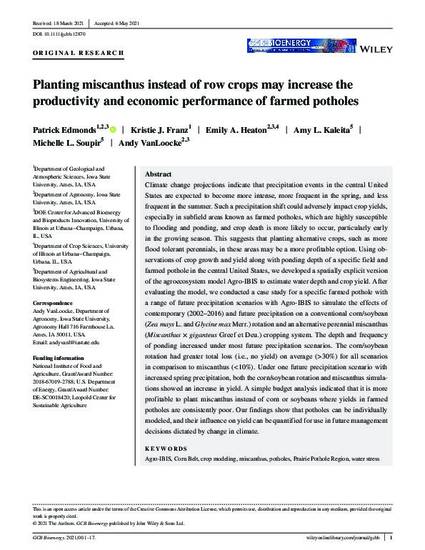
Climate change projections indicate that precipitation events in the central United States are expected to become more intense, more frequent in the spring, and less frequent in the summer. Such a precipitation shift could adversely impact crop yields, especially in subfield areas known as farmed potholes, which are highly susceptible to flooding and ponding, and crop death is more likely to occur, particularly early in the growing season. This suggests that planting alternative crops, such as more flood tolerant perennials, in these areas may be a more profitable option. Using observations of crop growth and yield along with ponding depth of a specific field and farmed pothole in the central United States, we developed a spatially explicit version of the agroecosystem model Agro-IBIS to estimate water depth and crop yield. After evaluating the model, we conducted a case study for a specific farmed pothole with a range of future precipitation scenarios with Agro-IBIS to simulate the effects of contemporary (2002–2016) and future precipitation on a conventional corn/soybean (Zea mays L. and Glycine max Merr.) rotation and an alternative perennial miscanthus (Miscanthus × giganteus Greef et Deu.) cropping system. The depth and frequency of ponding increased under most future precipitation scenarios. The corn/soybean rotation had greater total loss (i.e., no yield) on average (>30%) for all scenarios in comparison to miscanthus (<10%). Under one future precipitation scenario with increased spring precipitation, both the corn/soybean rotation and miscanthus simulations showed an increase in yield. A simple budget analysis indicated that it is more profitable to plant miscanthus instead of corn or soybeans where yields in farmed potholes are consistently poor. Our findings show that potholes can be individually modeled, and their influence on yield can be quantified for use in future management decisions dictated by change in climate.
Available at: http://works.bepress.com/andy_vanloocke/41/

This article is published as Edmonds, Patrick, Kristie J. Franz, Emily A. Heaton, Amy L. Kaleita, Michelle L. Soupir, and Andy VanLoocke. "Planting miscanthus instead of row crops may increase the productivity and economic performance of farmed potholes." GCB Bioenergy (2021). doi:10.1111/gcbb.12870.